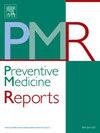体育活动和含糖饮料与美国年轻人肥胖的联合关联:NHANES 2007-2020的横断面分析
IF 2.4
3区 医学
Q2 PUBLIC, ENVIRONMENTAL & OCCUPATIONAL HEALTH
引用次数: 0
摘要
目的本研究旨在调查美国年轻人中含糖饮料(SSBs)和体育活动与肥胖之间的独立和联合关系。方法从2007-2020年全国健康与营养检查调查中选择11318名20-44岁的美国年轻人。身体活动是使用全球身体活动问卷自我报告的,而SSBs的摄入量是根据一天24小时的饮食回忆来计算的。使用多变量logistic回归模型和敏感性分析来估计SSBs、身体活动和肥胖之间的关联。结果肥胖4216例,占35.5%。研究发现,SSBs的摄入量与肥胖患病率呈正相关,而体育活动与肥胖患病率呈负相关。相对于中度SSBs消费+不运动的参与者,运动不足[调整优势比(AOR) = 0.75, 95% CI: 0.58, 0.97]和身体运动(AOR = 0.72, 95% CI: 0.62, 0.85)的中度SSBs消费者(1-499千卡/天)发生肥胖的可能性较低。然而,这种模式在重度SSBs消费者(≥500千卡/天)中没有发现(P >;0.05)。结论:体力活动与中度SSBs消费者中较低的肥胖患病率相关,而在重度SSBs消费者中没有观察到这种模式。需要进一步的研究来验证这些结果并确定因果关系。本文章由计算机程序翻译,如有差异,请以英文原文为准。
Joint association of physical activity and sugar-sweetened beverages with obesity in young U.S. adults: A cross-sectional analysis of NHANES 2007–2020
Objective
This study aimed to investigate the independent and joint association of sugar-sweetened beverages (SSBs) and physical activity with obesity among young U.S. adults.
Methods
We selected 11,318 U.S. young adults aged 20–44 years from the National Health and Nutrition Examination Survey (2007–2020). Physical activity was self-reported using the Global Physical Activity Questionnaire, while SSBs consumption was calculated from a single day of twenty-four-hour dietary recall. Multivariable logistic regression models, and sensitivity analyses were used to estimate the associations between SSBs, physical activity, and obesity.
Results
There were 4216 cases of obesity (35.5 %). A positive relationship between the consumption of SSBs and the prevalence of obesity was observed, while physical activity was negatively associated with the prevalence of obesity. Relative to the moderate SSBs consumption + inactive participants, those who were insufficiently active [adjusted odds ratio (AOR) = 0.75, 95 % CI: 0.58, 0.97] and physically active (AOR = 0.72, 95 % CI: 0.62, 0.85) had a lower likelihood of obesity among moderate SSBs consumers (1–499 kcal/day). However, this pattern was not found in the heavy SSBs consumers (≥ 500 kcal/day) (P > 0.05).
Conclusions
In conclusion, physical activity was associated with a lower prevalence of obesity among moderate SSBs consumers, while this pattern did not observe in heavy SSBs consumers. Further studies are needed to validate these results and determine causality.
求助全文
通过发布文献求助,成功后即可免费获取论文全文。
去求助
来源期刊

Preventive Medicine Reports
Medicine-Public Health, Environmental and Occupational Health
CiteScore
3.90
自引率
0.00%
发文量
353
 求助内容:
求助内容: 应助结果提醒方式:
应助结果提醒方式:


